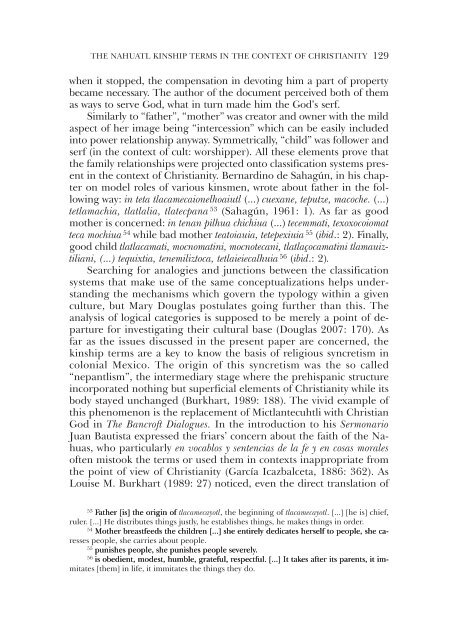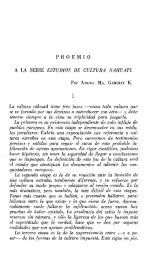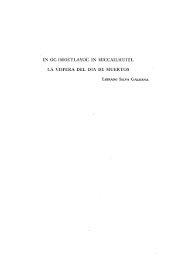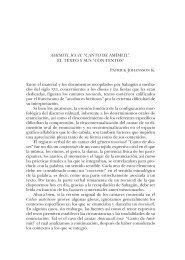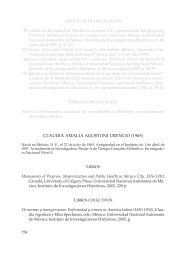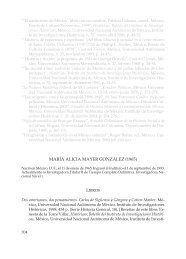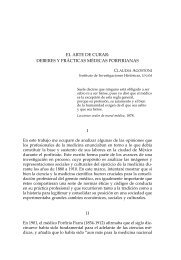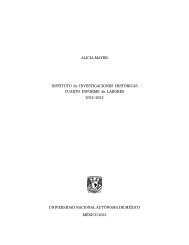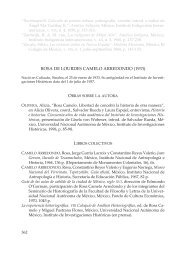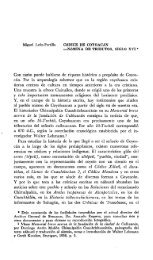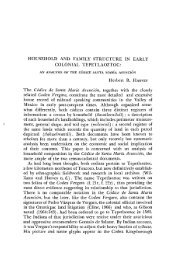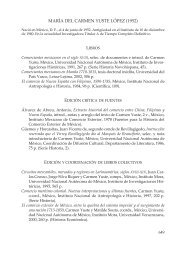“HOLY FAMILY”. THE NAHUATL KINSHIP TERMS IN THE ...
“HOLY FAMILY”. THE NAHUATL KINSHIP TERMS IN THE ...
“HOLY FAMILY”. THE NAHUATL KINSHIP TERMS IN THE ...
Create successful ePaper yourself
Turn your PDF publications into a flip-book with our unique Google optimized e-Paper software.
The Nahuatl kinship terms in the context of Christianity 129<br />
when it stopped, the compensation in devoting him a part of property<br />
became necessary. The author of the document perceived both of them<br />
as ways to serve God, what in turn made him the God’s serf.<br />
Similarly to “father”, “mother” was creator and owner with the mild<br />
aspect of her image being “intercession” which can be easily included<br />
into power relationship anyway. Symmetrically, “child” was follower and<br />
serf (in the context of cult: worshipper). All these elements prove that<br />
the family relationships were projected onto classification systems present<br />
in the context of Christianity. Bernardino de Sahagún, in his chapter<br />
on model roles of various kinsmen, wrote about father in the following<br />
way: in teta tlacamecaionelhoaiutl (...) cuexane, teputze, macoche. (...)<br />
tetlamachia, tlatlalia, tlatecpana 53 (Sahagún, 1961: 1). As far as good<br />
mother is concerned: in tenan pilhua chichiua (...) tecemmati, texoxocoiomat<br />
teca mochiua 54 while bad mother teatoiauia, tetepexiuia 55 (ibid.: 2). Finally,<br />
good child tlatlacamati, mocnomatini, mocnotecani, tlatlaçocamatini tlamauiztiliani,<br />
(...) tequixtia, tenemiliztoca, tetlaieiecalhuia 56 (ibid.: 2).<br />
Searching for analogies and junctions between the classification<br />
systems that make use of the same conceptualizations helps understanding<br />
the mechanisms which govern the typology within a given<br />
culture, but Mary Douglas postulates going further than this. The<br />
analysis of logical categories is supposed to be merely a point of departure<br />
for investigating their cultural base (Douglas 2007: 170). As<br />
far as the issues discussed in the present paper are concerned, the<br />
kinship terms are a key to know the basis of religious syncretism in<br />
colonial Mexico. The origin of this syncretism was the so called<br />
“nepantlism”, the intermediary stage where the prehispanic structure<br />
incorporated nothing but superficial elements of Christianity while its<br />
body stayed unchanged (Burkhart, 1989: 188). The vivid example of<br />
this phenomenon is the replacement of Mictlantecuhtli with Christian<br />
God in The Bancroft Dialogues. In the introduction to his Sermonario<br />
Juan Bautista expressed the friars’ concern about the faith of the Nahuas,<br />
who particularly en vocablos y sentencias de la fe y en cosas morales<br />
often mistook the terms or used them in contexts inappropriate from<br />
the point of view of Christianity (García Icazbalceta, 1886: 362). As<br />
Louise M. Burkhart (1989: 27) noticed, even the direct translation of<br />
53<br />
Father [is] the origin of tlacamecayotl, the beginning of tlacamecayotl. [...] [he is] chief,<br />
ruler. [...] He distributes things justly, he establishes things, he makes things in order.<br />
54<br />
Mother breastfeeds the children [...] she entirely dedicates herself to people, she caresses<br />
people, she carries about people.<br />
55<br />
punishes people, she punishes people severely.<br />
56<br />
is obedient, modest, humble, grateful, respectful. [...] It takes after its parents, it immitates<br />
[them] in life, it immitates the things they do.


